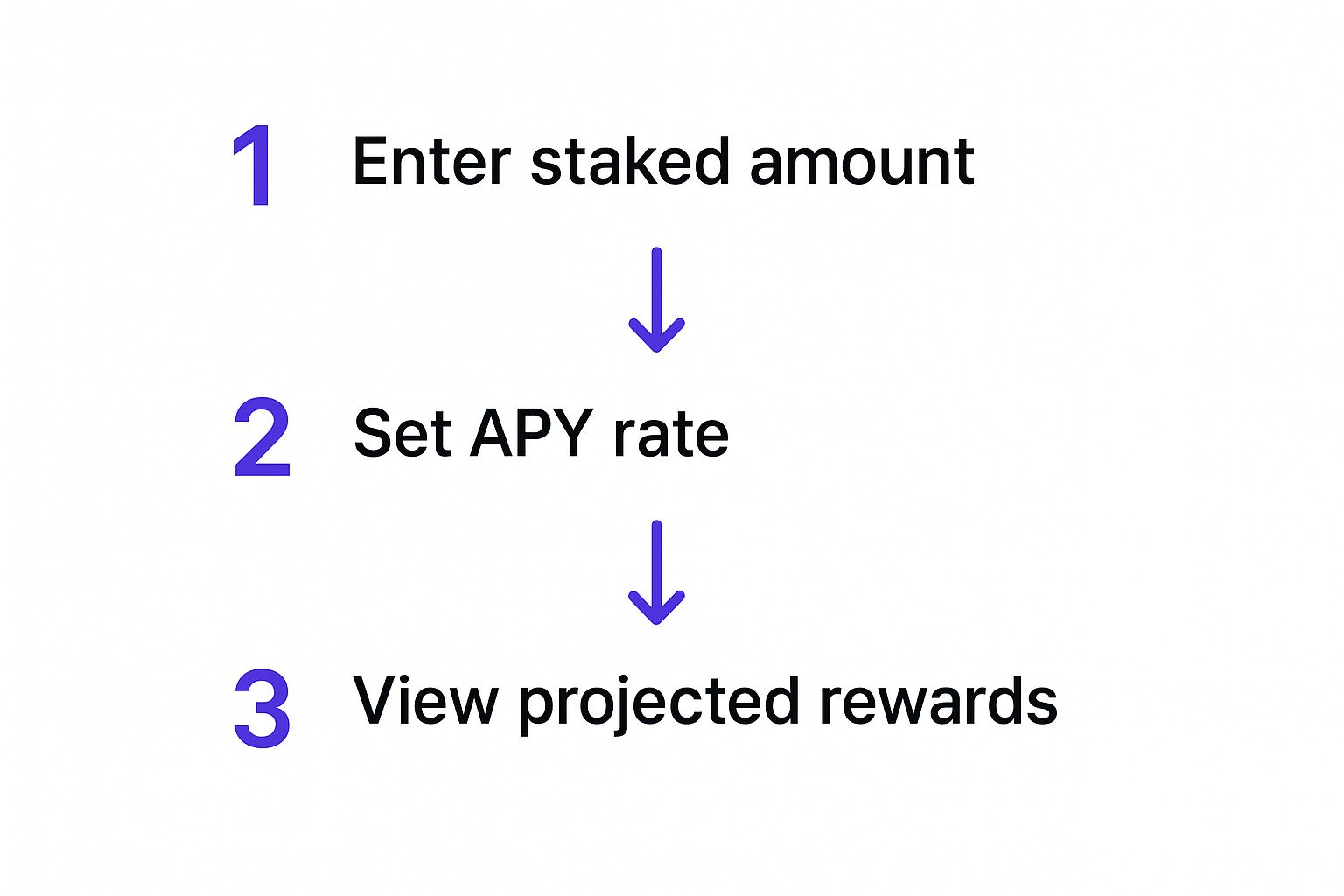A staking rewards calculator is one of the most practical tools in any crypto investor's arsenal. At its core, it’s designed to cut through the noise and forecast your potential earnings from staking. By plugging in key variables like your initial investment, the APY, and how long you plan to stake, it can project your returns—turning raw guesswork into a clear, data-driven strategy.
Why a Staking Calculator Is Your Most Important Tool

Let's be real: trying to eyeball your staking returns is a recipe for disappointment. The world of crypto staking is packed with moving parts that are almost impossible to track in your head. This is where a dedicated staking rewards calculator becomes indispensable, acting as the bridge between wishful thinking and a grounded investment plan.
Think of it as your financial co-pilot for navigating the crypto space. It takes the heavy lifting out of forecasting, letting you see potential outcomes without getting bogged down in complex spreadsheets. This is crucial because staking returns are never set in stone; they constantly shift with network conditions and other dynamic factors.
Decoding the Core Factors
A handful of critical elements drive your staking earnings, and any decent calculator worth its salt will account for all of them. These aren't just abstract numbers—they represent the real-world forces that determine how your investment grows.
The biggest ones to watch are:
- Network Inflation: This is the rate at which new tokens are minted and handed out as rewards, which directly impacts the yield you can expect.
- Total Staked Assets: The more tokens locked into the network by everyone else, the smaller your slice of the rewards pie becomes.
- Validator Fees: Validators run the infrastructure that makes staking possible, and they take a small commission from your gross rewards for their services.
These factors are all interconnected. A rise in one can cause a dip in another, creating a complex web that's tough to untangle manually. Calculators are essential for making sense of it all, especially with the compounding effects and fluctuating rates. Many of the best tools pull real-time data from networks like Ethereum (ETH) and Solana (SOL) to deliver accurate annual yield estimates based on these very parameters.
A staking rewards calculator strips the emotion out of your investment strategy. It grounds your decisions in hard data, helping you objectively compare different assets and timelines to find the path that truly aligns with your financial goals.
Inputs and Projections
To get a forecast, you just need to feed the calculator a few key details. It handles the rest, painting a clear picture of what you might earn. This simple input-output process is what makes it so powerful.
Before you start plugging in numbers, it helps to understand exactly what a calculator needs from you and what it gives back. This table breaks down the essentials.
Key Inputs and Outputs of a Staking Rewards Calculator
| Input/Output | Description | Example |
|---|---|---|
| Initial Investment | The amount of cryptocurrency you plan to stake. | 100 SOL |
| APY/APR | The Annual Percentage Yield or Rate, which is your projected annual return. | 7.2% |
| Staking Duration | The length of time you intend to keep your assets staked. | 1 Year |
| Compounding Frequency | How often your earned rewards are added back to your principal stake. | Daily |
| Projected Earnings | The total profit you can expect over your chosen duration. | 7.45 SOL |
| Total Balance | Your initial investment plus your projected earnings. | 107.45 SOL |
Ultimately, the process is straightforward: you tell the calculator what you're working with, and it shows you what that could grow into. By getting familiar with these inputs and outputs, you’ll be much better equipped to plan your crypto journey.
You can see this in action and explore different assets on the vTrader staking platform.
The Simple Math That Powers Your Staking Returns

You don’t need to be a math whiz to figure out how your staked crypto multiplies. At the heart of every good staking rewards calculator is an engine you probably remember from high school finance class: compound interest. It’s the classic "snowball effect" applied to your digital assets, where your earnings start generating their own rewards.
The core logic isn't some black box mystery. It’s built on the same principles you’d use to calculate the ROI of your crypto investment. While the formula might look a bit formal at first, it's actually quite simple once you break it down.
Most crypto staking calculators rely on a standard compound interest formula to project your earnings. The most common one you'll see is A = P(1 + r)^t. It gives you a clear picture of how your bags can grow over different timeframes.
Breaking Down the Formula
Let's pull back the curtain on that equation. Once you see what each letter represents, the whole thing becomes much less intimidating.
- P (Principal): This one's easy. It's your starting investment—the initial amount of crypto you're putting up to stake.
- r (Rate): This is your Annual Percentage Yield (APY), but as a decimal. So, if the APY is 12%, you'd plug in 0.12 for the calculation.
- t (Time): This is how long you plan to keep your assets staked, typically measured in years.
- A (Future Value): This is the final number the calculator spits out—your original stake plus all the compounded rewards it has accumulated.
This formula is precisely what turns small, steady rewards into serious growth down the line.
Think of it this way: your initial stake (Principal) is a small snowball at the top of a hill. The rewards are the fresh snow it collects on the way down. Compounding is what happens when that slightly bigger snowball keeps rolling, gathering even more snow with each turn.
A Real-World Staking Example
Okay, let's make this tangible. Imagine you decide to stake $1,000 worth of a coin that offers a 12% APY. Your game plan is to let it sit and compound for five years.
Without a calculator, your first instinct might be to assume you'll make $120 a year ($1,000 x 12%). Over five years, that’s $600 in profit, right? A final balance of $1,600. But that's not how compounding works.
Let's run the numbers through the formula: A = 1000 * (1 + 0.12)^5.
A proper staking calculator would crunch this and show a final value of around $1,762. That extra $162 is the magic of compounding in action. It’s the profit your profit started making.
The frequency of compounding matters, too. Rewards that compound daily will grow slightly faster than those that compound monthly because they're put back to work sooner. A solid calculator handles all these details for you, giving you a sharp forecast without the headache. Understanding this is what separates a casual tool user from a savvy investor.
A Practical Walkthrough of a Staking Calculator
Okay, theory is one thing, but getting your hands dirty with a real-world staking rewards calculator is where the lightbulb really goes on. Let's shift from concepts to clicks and run through how these tools actually work. This isn't just another generic tutorial—it's a playbook to get you comfortable with forecasting your staking rewards from the very first try.
Most calculators are designed to be pretty intuitive. You can think of the whole process in three simple parts, as this graphic shows.

As you can see, it’s a straight shot from input to insight. You give it your principal and the expected rate, and it crunches the numbers to project your earnings.
Navigating the Calculator Interface
When you fire up a staking calculator for the first time, you’ll be greeted by a few standard input fields. They look simple, but knowing exactly what each one means is crucial for getting a forecast you can actually rely on.
Here’s a snapshot of a clean, typical layout you might see on a platform.

The interface is built to be straightforward, asking only for the essentials. Let's break down how to handle each field to get the most accurate results.
-
Select Your Crypto: This is your starting point. You’ll pick the asset you intend to stake from a dropdown list. Many of the better calculators will automatically fetch the current APY for major coins like Ethereum or Solana, which is a nice time-saver.
-
Enter Your Stake Amount: This is your principal investment. You can type it in as a number of coins (e.g., 150 ATOM) or its current dollar value. I usually find that entering the coin amount gives a more precise crypto-native calculation.
-
Set the APY/Reward Rate: If the tool doesn't fill this in for you, you’ll need to enter it manually. Grab this figure from reliable sources like the staking provider’s website or a network explorer. It's tempting to use the highest possible rate you can find, but be realistic here for a more grounded projection.
Once you’ve plugged in these details, the calculator will almost instantly show your projected returns, often broken down into daily, monthly, and yearly earnings.
Interpreting Your Projections
Now for the fun part—the results. A good calculator doesn't just spit out a single number. It shows you how your earnings could accumulate over different timeframes, which really helps you see the power of daily compounding and visualize the long-term potential.
Your projected yearly return is a powerful headline number, but don't ignore the daily and monthly figures. They provide a tangible sense of how your assets are working for you in the short term, which can be highly motivating.
Some tools pack in more advanced features, too. You might be able to compare different assets side-by-side or even punch in a validator’s commission fee to see a more accurate net return. Playing around with these options can give you a much richer picture of your potential rewards.
And for anyone looking to go a bit deeper, you can find a ton of great educational content over at the vTrader Academy to build on what you learn here. After all, this is about piecing together a complete strategy, from calculation to execution.
Modeling Real-World Staking Scenarios
This is where the rubber meets the road. A staking rewards calculator is great for theory, but its real power comes alive when you start plugging in real-world numbers. It’s the difference between knowing a formula and actually seeing how it could play out with your own assets.
Let's run through a few common scenarios. These examples will show you just how valuable a calculator can be for comparing different assets, strategies, and timelines.
Blue-Chip Stability vs. High-Yield Altcoins
First up, the classic dilemma: Do you go with a proven, stable giant or take a flyer on a riskier altcoin with a juicy APY? Let's put Ethereum (ETH), a market leader, head-to-head with a hypothetical high-yield altcoin we'll call "AltCoinX."
Ethereum is the undisputed king of staking, with roughly 33.8 million ETH currently locked in to secure the network. That massive scale brings stability but also means more modest yields, which often hover just under 5%. Liquid staking is particularly dominant here, commanding a 31.1% market share because it frees up stakers' capital.
Let's see what that looks like in the calculator.
- Asset: Ethereum (ETH)
- Initial Stake: 1 ETH (around $3,500)
- APY: 4.5%
- Projected 1-Year Return: 0.045 ETH (or about $157.50)
Now, let's punch in the numbers for AltCoinX, which promises a much higher reward.
- Asset: AltCoinX
- Initial Stake: $3,500
- APY: 15%
- Projected 1-Year Return: $525
The calculator lays the trade-off bare. AltCoinX offers more than triple the potential reward, but you have to assume that higher yield comes with much greater risk—think price swings and network vulnerabilities. Ethereum, on the other hand, represents a slower, more predictable path to growth.
To give you a clearer picture, here’s a quick table comparing a few different staking possibilities.
Staking Scenarios Comparison
This table offers a comparative look at potential outcomes from staking different assets under various conditions, helping illustrate the trade-offs between stability and high-yield potential.
| Scenario | Asset | Initial Stake | APY | Projected 1-Year Return |
|---|---|---|---|---|
| Stable Blue-Chip | Ethereum (ETH) | $3,500 | 4.5% | $157.50 |
| High-Yield Altcoin | AltCoinX | $3,500 | 15% | $525 |
| Mid-Cap Growth | Chainlink (LINK) | $3,500 | 7% | $245 |
| Ecosystem Staking | Solana (SOL) | $3,500 | 6.5% | $227.50 |
As you can see, the numbers tell a compelling story. Your projected returns can vary dramatically based on the asset's risk profile and offered APY.
A Lump Sum vs. Consistent Contributions
Here's another powerful way to use a staking calculator: comparing investment strategies. Is it better to stake a big chunk of capital all at once, or should you consistently add smaller amounts over time? Let's model this out over five years.
The Lump Sum Approach:
Imagine you stake $10,000 today in an asset that offers an 8% APY. If you let it ride for five years, the calculator would project a final balance of roughly $14,693 thanks to the power of compounding.
The Consistent Staking Approach:
What if you started with $2,000 and then added another $2,000 every year for the next four years? This strategy, often called dollar-cost averaging, can be a pain to calculate by hand. A good calculator, however, would estimate your final balance to be around $13,000.
In this specific case, the lump sum comes out ahead. But for many people, the consistent approach is far more realistic for building a portfolio over the long haul.
Ultimately, there’s no single "best" way to stake. The right choice boils down to your personal financial situation, your goals, and how much risk you're comfortable taking. To stay ahead of market trends that might influence your decisions, you can always check for updates on the vTrader news hub.
Thinking Beyond the Calculator for a Winning Strategy

A staking rewards calculator is a fantastic starting point for running the numbers, but your projections are only as strong as the strategy behind them. The calculator shows you the "what," but a winning approach demands you understand the "why" and, more importantly, the "what if."
The raw numbers simply don't show the full picture. A sky-high APY looks great on paper, but it’s almost meaningless if the validator you choose is unreliable. Think of it this way: the calculator assumes a perfect world, but reality is rarely so neat. This is where your own insight becomes your most valuable asset.
Evaluate Risks the Numbers Don't Show
Before you commit your assets, you absolutely have to look past the shiny APY and assess the risks that every staker faces. These factors can hit your bottom line hard—sometimes harder than a small difference in yield.
Here are the key areas to dig into:
- Slashing Risk: This is the big one. It's a penalty the network imposes when a validator misbehaves, whether maliciously or through major downtime. If your validator gets slashed, you could lose a chunk of your staked assets.
- Validator Uptime: A validator that’s frequently offline isn't signing blocks, which means you aren't earning rewards. It’s that simple. You should be aiming for validators with an uptime of 99% or higher.
- Commission Fees: Validators take a cut of your gross rewards for their services. These fees can swing wildly from 0% to over 20%, so it's a crucial variable that directly impacts your real, take-home returns.
While our platform simplifies trading, you can learn more about how different commission structures on vTrader compare to staking validator fees.
A staking calculator is a tool for projection, not a crystal ball. Your job is to use its output as a baseline, then adjust your expectations based on the real-world risks tied to your chosen asset and validator.
Balancing High APY with Smart Risk Management
The temptation to chase the highest possible APY is strong, but it's often a trap for newcomers. An unusually high yield can be a red flag, signaling deeper risks like extreme token price volatility or a sketchy, unproven network.
Your real goal should be to find a healthy balance. Sometimes, a lower, more stable yield from a well-respected validator on an established network is a much smarter long-term play.
And finally, never forget about token price volatility. Your rewards are paid out in the network's native token. A 10% APY is great until the token's price crashes by 30%. Your staking calculator won’t predict market swings; it's on you to consider how price fluctuations could affect the actual dollar value of your earnings when you decide to cash out.
Common Questions About Staking Calculators
Even after you get the hang of using a staking rewards calculator, it's totally normal for a few practical questions to pop up. Honestly, it happens to everyone. Let's run through some of the most common queries I hear, so you can use these tools with total confidence.
Think of this as tying up the loose ends. We’ve walked through the what and the how—now it’s time to tackle the "what ifs" that are probably floating around in your head.
How Accurate Are These Calculators?
This is, without a doubt, the question I get asked most often. The short answer? Staking rewards calculators give you estimates, not guarantees. Their accuracy is only as good as the data you feed them, especially the Annual Percentage Yield (APY).
APY can swing based on things like network activity, how well validators are performing, and any changes to the protocol itself. Because of that, these calculators are fantastic for short-term projections and comparing different assets. They aren't crystal balls for predicting your exact balance down to the last satoshi a year from now.
Here’s a pro tip I always share: get in the habit of revisiting your calculations every so often, maybe once a quarter. This lets you adjust for any big swings in APY and keeps your financial roadmap grounded in reality.
Do Calculators Include Fees or Taxes?
Most of the standard calculators out there are designed to show you gross returns. They don't automatically pull in external costs, which is a critical detail to remember when you see that final projection.
You'll need to account for a couple of things yourself:
- Validator Fees: Validators take a commission from your rewards for their service. You’ll have to manually subtract this percentage from the APY to see a true net estimate.
- Taxes: In many places, staking rewards are treated as taxable income. The calculator won't handle this part for you, so it's on you to know the tax rules where you live.
Some of the more advanced calculators might have a field for commission fees, but you can bet that taxes will almost always be something you need to figure out on your own.
What Is the Difference Between APR and APY?
Nailing the difference between APR and APY is absolutely essential for an accurate forecast. I see people use them interchangeably all the time, but they’re two completely different ways of calculating returns.
APR (Annual Percentage Rate) is just the simple interest you earn over a year, completely ignoring the power of compounding. It's a flat rate.
APY (Annual Percentage Yield), on the other hand, is where the magic happens. It includes the effects of compounding. Since your rewards are periodically added back to your staked amount and start earning their own rewards, APY provides a much more realistic picture of your potential growth. Always double-check which one your calculator is using.
For more granular details on platform features or other common questions, diving into a comprehensive FAQ page can clear things up even further.
Ready to stop guessing and start calculating? With vTrader, you get access to powerful tools and zero-fee trading to maximize your returns. Join today, claim your $10 sign-up bonus, and build your crypto portfolio the smart way. Start trading with vTrader.

Steve Gregory is a lawyer in the United States who specializes in licensing for cryptocurrency companies and products. Steve began his career as an attorney in 2015 but made the switch to working in cryptocurrency full time shortly after joining the original team at Gemini Trust Company, an early cryptocurrency exchange based in New York City. Steve then joined CEX.io and was able to launch their regulated US-based cryptocurrency. Steve then went on to become the CEO at currency.com when he ran for four years and was able to lead currency.com to being fully acquired in 2025.


